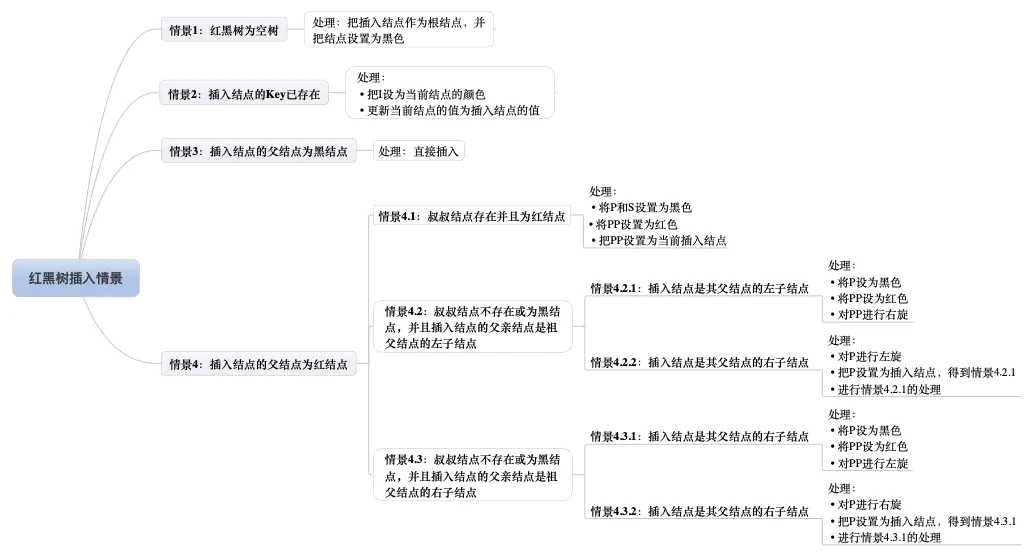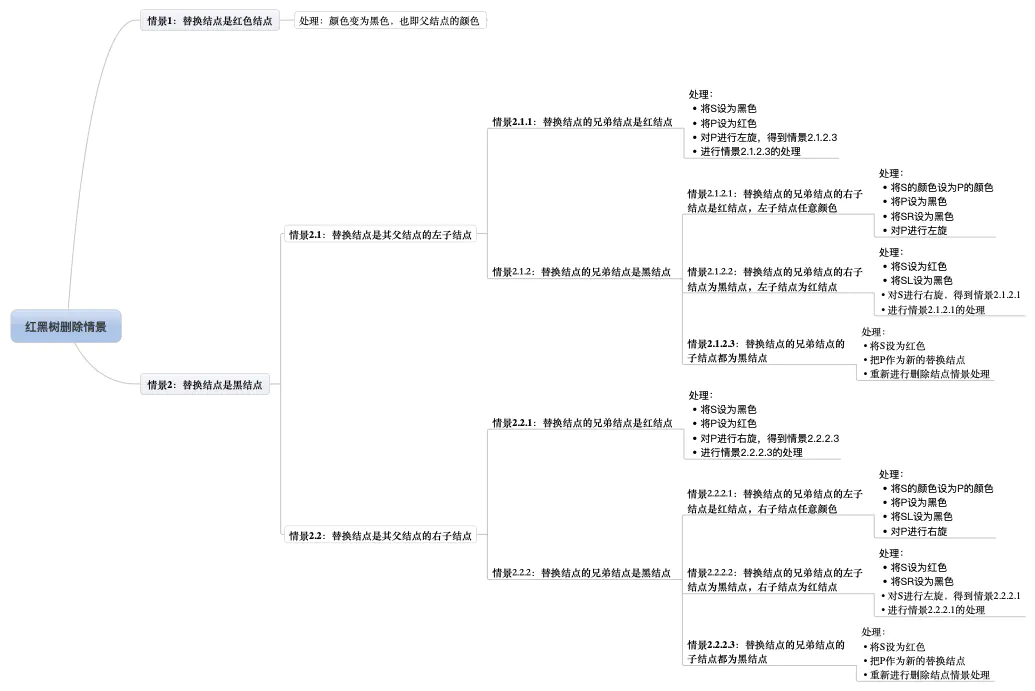(温馨提示:还未了解 红黑树 的插入、删除节点原理的同学,请先学习本人前一篇博文《【数据结构】红黑树 详解》)
在之前的博文《【数据结构】红黑树 详解》中,
本人讲解了 红黑树 的 数据结构 和 设计理念,并对其 增删查 操作做了 详细 的 讲解
那么,在本篇博文中,本人将结合 JDK1.8 版本的 HashMap 的 内部类 —— TreeNode类 进行下分析:
首先,本人了展示下 TreeNode类 的 源码:
TreeNode类 源码:
下载链接(免费,按需求下载)
相信第一次看到 TreeNode类的源码 的同学,心中一定无比震惊
(这特喵的,将近600行代码,读完怕不是要升天... ...)
首先是 成员变量:
成员变量:
TreeNode<K,V> parent; // 当前节点的 “父节点”
TreeNode<K,V> left; // 当前节点的 “左孩子节点”
TreeNode<K,V> right; // 当前节点的 “右孩子节点”
TreeNode<K,V> prev; // 当前节点的 “前一个录入节点”
boolean red; // 当前节点的 颜色
我们看任何类的 方法源码,都应该从其 构造方法 开始解析:
构造方法:
/**
* 根据参数所传 哈希值、键值对、下一个节点的指针,构造 红黑树节点
*/
TreeNode(int hash, K key, V val, Node<K,V> next) {
super(hash, key, val, next); // 这里的super构造,最终生成的是一个 Node类型 的节点
}
当然,在本篇博文中,本人不会对TreeNode类进行全文讲解
还是照往常一样,本人来讲解其中的几个 比较重要 且 被 JDK1.8版本的HashMap类调用 的方法:
说到 JDK1.8的HashMap 和 TreeNode类,
相信我们的脑海中就会出现如下几个方法:
| 方法名 | 功能 |
|---|---|
| treeify | 树化 当前链表 |
| getTreeNode | 在 当前红黑树 中 查找 目标键所在节点 |
| putTreeVal | 向 当前红黑树 中 插入 新节点 |
| removeTreeNode | 在 当前红黑树 中 删除 目标键所在节点 |
| untreeify | 反树化 当前红黑树 |
treeify(树化) :
/**
* 根据当前哈希表 生成 红黑树
* @return 红黑树 的 根节点
*/
final void treeify(Node<K, V>[] tab) {
TreeNode<K, V> root = null;
for (TreeNode<K, V> x = this, next; x != null; x = next) {
next = (TreeNode<K, V>) x.next;
x.left = x.right = null; // 将当前节点的 左孩子和右孩子 全部置为null
if (root == null) { // 将当前节点设置为 红黑树的“黑色根节点“”
x.parent = null;
x.red = false;
root = x;
} else {
K k = x.key;
int h = x.hash;
Class<?> kc = null;
/*
根据 当前节点的hash,计算 当前节点应在位置
1、根据AVL树的规则:左 < 父 < 右
2、若找到,则 插入并平衡
*/
for (TreeNode<K, V> p = root; ; ) {
int dir, ph;
K pk = p.key;
if ((ph = p.hash) > h)
dir = -1;
else if (ph < h)
dir = 1;
else if ((kc == null &&
(kc = comparableClassFor(k)) == null) ||
(dir = compareComparables(kc, k, pk)) == 0) //判断 当前键 和 p是否相等
dir = tieBreakOrder(k, pk);
TreeNode<K, V> xp = p;
if ((p = (dir <= 0) ? p.left : p.right) == null) {
x.parent = xp;
if (dir <= 0)
xp.left = x;
else
xp.right = x;
root = balanceInsertion(root, x); // 在指定位置插入目标节点,并平衡化 “插入后”的红黑树
break;
}
}
}
}
moveRootToFront(tab, root);
}
本人现在来总结下 树化 的步骤:
1、将 每个节点 转换为TreeNode类型
2、将 每个节点 插入 当前bin的红黑树中
3、将 当前红黑树的root放入 当前bin中(保证是当前bin的第一个元素)
那么,本人接下来来讲解下 上述方法中所调用的三个方法:
comparableClassFor() 方法:
/**
* 如果x实现“Comparable接口”,则返回x的类,
* 否则返回null。
*/
static Class<?> comparableClassFor(Object x) {
if (x instanceof Comparable) {
Class<?> c;
Type[] ts, as;
Type t;
ParameterizedType p;
if ((c = x.getClass()) == String.class) // 绕过检查
return c;
if ((ts = c.getGenericInterfaces()) != null) {
for (int i = 0; i < ts.length; ++i) {
if (((t = ts[i]) instanceof ParameterizedType) &&
((p = (ParameterizedType) t).getRawType() ==
Comparable.class) &&
(as = p.getActualTypeArguments()) != null &&
as.length == 1 && as[0] == c) // type arg is c
return c;
}
}
}
return null;
}
本人来概括一下:
若 参数的类型 实现了 Comparable接口 或 为String,则返回 参数的类型
否则,返回null
compareComparables() 方法:
/**
* 如果x匹配kc(k的筛选的可比类),则返回k.compareTo(x),
* 否则返回0。
*/
@SuppressWarnings({"rawtypes","unchecked"}) // for cast to Comparable
static int compareComparables(Class<?> kc, Object k, Object x) {
return (x == null || x.getClass() != kc ? 0 :
((Comparable)k).compareTo(x));
}
本人来概括一下:
若 参数的类型 实现了 Comparable接口 或 为String,则返回 按照 所传类型 的 比较算法 的 比较结果
否则,返回0
tieBreakOrder() 方法:
/**
* Tie-breaking utility for ordering insertions when equal
* hashCodes and non-comparable. We don't require a total
* order, just a consistent insertion rule to maintain
* equivalence across rebalancings. Tie-breaking further than
* necessary simplifies testing a bit.
*/
static int tieBreakOrder(Object a, Object b) {
int d;
if (a == null || b == null ||
(d = a.getClass().getName().
compareTo(b.getClass().getName())) == 0)
d = (System.identityHashCode(a) <= System.identityHashCode(b) ?
-1 : 1);
return d;
}
以上的代码调用到了 本地方法,本人就来讲解下上述方法的大致作用:
比较 俩参数 的值
balanceInsertion() 方法:
/**
* 插入 目标节点,并 平衡“插入后”的红黑树
* @param root 目标根节点
* @param x 目标节点
* @param <K> 键类型
* @param <V> 值类型
* @return 插入平衡后的 根节点
*/
static <K, V> TreeNode<K, V> balanceInsertion(TreeNode<K, V> root, TreeNode<K, V> x) {
x.red = true; // 红黑树规则:新节点默认为“红节点”
for (TreeNode<K, V> xp, xpp, xppl, xppr; ; ) {
if ((xp = x.parent) == null) {
x.red = false;
return x;
} else if (!xp.red || (xpp = xp.parent) == null)
return root;
if (xp == (xppl = xpp.left)) {
if ((xppr = xpp.right) != null && xppr.red) {
xppr.red = false;
xp.red = false;
xpp.red = true;
x = xpp;
} else {
if (x == xp.right) {
root = rotateLeft(root, x = xp); // 左旋
xpp = (xp = x.parent) == null ? null : xp.parent;
}
if (xp != null) {
xp.red = false;
if (xpp != null) {
xpp.red = true;
root = rotateRight(root, xpp); // 右旋
}
}
}
} else {
if (xppl != null && xppl.red) {
xppl.red = false;
xp.red = false;
xpp.red = true;
x = xpp;
} else {
if (x == xp.left) {
root = rotateRight(root, x = xp);
xpp = (xp = x.parent) == null ? null : xp.parent;
}
if (xp != null) {
xp.red = false;
if (xpp != null) {
xpp.red = true;
root = rotateLeft(root, xpp);
}
}
}
}
}
}
那么,本人现在来展示下 上述方法中所调用的 左旋/右旋 方法:
rotateLeft(左旋):
实现代码:
static <K,V> TreeNode<K,V> rotateLeft(TreeNode<K,V> root, TreeNode<K,V> p) {
TreeNode<K,V> r, pp, rl;
if (p != null && (r = p.right) != null) {
if ((rl = p.right = r.left) != null)
rl.parent = p;
if ((pp = r.parent = p.parent) == null)
(root = r).red = false;
else if (pp.left == p)
pp.left = r;
else
pp.right = r;
r.left = p;
p.parent = r;
}
return root;
}
示意图:

rotateRight(右旋):
实现代码:
static <K,V> TreeNode<K,V> rotateRight(TreeNode<K,V> root, TreeNode<K,V> p) {
TreeNode<K,V> l, pp, lr;
if (p != null && (l = p.left) != null) {
if ((lr = p.left = l.right) != null)
lr.parent = p;
if ((pp = l.parent = p.parent) == null)
(root = l).red = false;
else if (pp.right == p)
pp.right = l;
else
pp.left = l;
l.right = p;
p.parent = l;
}
return root;
}
示意图:

至于上述方法的步步解析,本人来给出执行的步骤图:
流程图:

由于在本人之前的博文《【数据结构】红黑树 详解》中进行了讲解
那么,本人就不进行步步解析了,有兴趣的同学请观看《【数据结构】红黑树 详解》

那么,本人现在来讲解下 查找目标节点 的 getTreeNode() 方法:
getTreeNode(搜索):
/**
* 根据 根节点,调用find()方法
*/
final TreeNode<K,V> getTreeNode(int h, Object k) {
return ((parent != null) ? root() : this).find(h, k, null);
}
那么,本人现在来展示下上述方法中所调用的两个方法:
root() 方法:
/**
* 返回 包含当前节点的 根节点
*/
final HashMap.TreeNode<K, V> root() {
for (HashMap.TreeNode<K, V> r = this, p; ; ) {
if ((p = r.parent) == null)
return r;
r = p;
}
}
find() 方法:
/**
* 从根p开始的节点,查找具有给定哈希值和键的节点。
* 若不存在,则返回null
* @param h 目标哈希值
* @param k 目标键
* @param kc 目标key的Class对象
* @return 返回 根据 参数及当前红黑树,计算出的 目标节点
*/
final HashMap.TreeNode<K, V> find(int h, Object k, Class<?> kc) {
HashMap.TreeNode<K, V> p = this;
do {
int ph, dir;
K pk;
HashMap.TreeNode<K, V> pl = p.left, pr = p.right, q;
if ((ph = p.hash) > h)
p = pl;
else if (ph < h)
p = pr;
else if ((pk = p.key) == k || (k != null && k.equals(pk)))
return p;
else if (pl == null)
p = pr;
else if (pr == null)
p = pl;
else if ((kc != null ||
(kc = comparableClassFor(k)) != null) &&
(dir = compareComparables(kc, k, pk)) != 0)
p = (dir < 0) ? pl : pr;
else if ((q = pr.find(h, k, kc)) != null)
return q;
else
p = pl;
} while (p != null);
return null;
}
那么,接下来就是 putTreeVal()方法:
putTreeVal(插入):
/**
* 在目标红黑树中,插入目标节点
* @param map 当前HashMap对象
* @param tab 当前哈希表
* @param h 目标hash值
* @param k 目标key
* @param v 目标value
* @return 被覆盖的节点
*/
final HashMap.TreeNode<K, V> putTreeVal(HashMap<K, V> map, HashMap.Node<K, V>[] tab,
int h, K k, V v) {
Class<?> kc = null;
boolean searched = false;
HashMap.TreeNode<K, V> root = (parent != null) ? root() : this;
for (HashMap.TreeNode<K, V> p = root; ; ) {
/*
查找 目标节点 应在位置
*/
int dir, ph;
K pk;
if ((ph = p.hash) > h)
dir = -1;
else if (ph < h)
dir = 1;
else if ((pk = p.key) == k || (k != null && k.equals(pk)))
return p;
else if ((kc == null &&
(kc = comparableClassFor(k)) == null) ||
(dir = compareComparables(kc, k, pk)) == 0) {
if (!searched) {
HashMap.TreeNode<K, V> q, ch;
searched = true;
if (((ch = p.left) != null &&
(q = ch.find(h, k, kc)) != null) ||
((ch = p.right) != null &&
(q = ch.find(h, k, kc)) != null))
return q;
}
dir = tieBreakOrder(k, pk);
}
HashMap.TreeNode<K, V> xp = p;
if ((p = (dir <= 0) ? p.left : p.right) == null) {
HashMap.Node<K, V> xpn = xp.next;
HashMap.TreeNode<K, V> x = map.newTreeNode(h, k, v, xpn);
if (dir <= 0)
xp.left = x;
else
xp.right = x;
xp.next = x;
x.parent = x.prev = xp;
if (xpn != null)
((HashMap.TreeNode<K, V>) xpn).prev = x;
moveRootToFront(tab, balanceInsertion(root, x)); // 插入并平衡目标节点,且 将目标根放于哈希表的恰当单元的第一个节点
return null;
}
}
}
那么,本人现在来展示下上述方法中所调用的moveRootToFront()方法:
moveRootToFront() 方法:
/**
* 确保 参数root 是 其bin的第一个节点
*/
static <K, V> void moveRootToFront(HashMap.Node<K, V>[] tab, HashMap.TreeNode<K, V> root) {
int n;
if (root != null && tab != null && (n = tab.length) > 0) {
int index = (n - 1) & root.hash;
HashMap.TreeNode<K, V> first = (HashMap.TreeNode<K, V>) tab[index];
if (root != first) {
HashMap.Node<K, V> rn;
tab[index] = root;
HashMap.TreeNode<K, V> rp = root.prev;
if ((rn = root.next) != null)
((HashMap.TreeNode<K, V>) rn).prev = rp;
if (rp != null)
rp.next = rn;
if (first != null)
first.prev = root;
root.next = first;
root.prev = null;
}
assert checkInvariants(root);
}
}
那么,最后就是 代表删除 的 removeTreeNode() 方法:
removeTreeNode(删除):
/**
* 删除此调用之前必须存在的给定节点。
* 这比典型的红黑删除代码更为混乱,因为我们无法将内部节点的内容与由在遍历期间可独立访问的“下一个”指针固定的叶子后继对象交换。
* 因此,我们交换树链接。
* 如果当前树的节点太少,则将bin转换回普通bin数组。
* (该方法触发2到6个节点之间的某个位置,具体取决于树的结构)。
*/
final void removeTreeNode(HashMap<K,V> map, Node<K,V>[] tab,
boolean movable) {
int n;
if (tab == null || (n = tab.length) == 0)
return;
int index = (n - 1) & hash;
TreeNode<K,V> first = (TreeNode<K,V>)tab[index], root = first, rl;
TreeNode<K,V> succ = (TreeNode<K,V>)next, pred = prev;
if (pred == null)
tab[index] = first = succ;
else
pred.next = succ;
if (succ != null)
succ.prev = pred;
if (first == null)
return;
if (root.parent != null)
root = root.root();
if (root == null || root.right == null ||
(rl = root.left) == null || rl.left == null) {
tab[index] = first.untreeify(map); // 节点数过少,反树化
return;
}
TreeNode<K,V> p = this, pl = left, pr = right, replacement;
if (pl != null && pr != null) {
TreeNode<K,V> s = pr, sl;
while ((sl = s.left) != null) // find successor
s = sl;
boolean c = s.red; s.red = p.red; p.red = c; // swap colors
TreeNode<K,V> sr = s.right;
TreeNode<K,V> pp = p.parent;
if (s == pr) { // p was s's direct parent
p.parent = s;
s.right = p;
}
else {
TreeNode<K,V> sp = s.parent;
if ((p.parent = sp) != null) {
if (s == sp.left)
sp.left = p;
else
sp.right = p;
}
if ((s.right = pr) != null)
pr.parent = s;
}
p.left = null;
if ((p.right = sr) != null)
sr.parent = p;
if ((s.left = pl) != null)
pl.parent = s;
if ((s.parent = pp) == null)
root = s;
else if (p == pp.left)
pp.left = s;
else
pp.right = s;
if (sr != null)
replacement = sr;
else
replacement = p;
}
else if (pl != null)
replacement = pl;
else if (pr != null)
replacement = pr;
else
replacement = p;
if (replacement != p) {
TreeNode<K,V> pp = replacement.parent = p.parent;
if (pp == null)
root = replacement;
else if (p == pp.left)
pp.left = replacement;
else
pp.right = replacement;
p.left = p.right = p.parent = null;
}
TreeNode<K,V> r = p.red ? root : balanceDeletion(root, replacement);
if (replacement == p) { // detach
TreeNode<K,V> pp = p.parent;
p.parent = null;
if (pp != null) {
if (p == pp.left)
pp.left = null;
else if (p == pp.right)
pp.right = null;
}
}
if (movable)
moveRootToFront(tab, r);
}
这里需要注意的是:
当
$$
节点数 == 6
$$
时,将会执行反树化方法()
那么,本人现在来展示下 上述方法中所调用的 balanceDeletion()方法:
balanceDeletion() 方法:
/**
* 删除 并 平衡 “删除后”的红黑树
* @return 删除掉的节点
*/
static <K,V> TreeNode<K,V> balanceDeletion(TreeNode<K,V> root, TreeNode<K,V> x) {
for (TreeNode<K,V> xp, xpl, xpr;;) {
if (x == null || x == root)
return root;
else if ((xp = x.parent) == null) {
x.red = false;
return x;
}
else if (x.red) {
x.red = false;
return root;
}
else if ((xpl = xp.left) == x) {
if ((xpr = xp.right) != null && xpr.red) {
xpr.red = false;
xp.red = true;
root = rotateLeft(root, xp);
xpr = (xp = x.parent) == null ? null : xp.right;
}
if (xpr == null)
x = xp;
else {
TreeNode<K,V> sl = xpr.left, sr = xpr.right;
if ((sr == null || !sr.red) &&
(sl == null || !sl.red)) {
xpr.red = true;
x = xp;
}
else {
if (sr == null || !sr.red) {
if (sl != null)
sl.red = false;
xpr.red = true;
root = rotateRight(root, xpr);
xpr = (xp = x.parent) == null ?
null : xp.right;
}
if (xpr != null) {
xpr.red = (xp == null) ? false : xp.red;
if ((sr = xpr.right) != null)
sr.red = false;
}
if (xp != null) {
xp.red = false;
root = rotateLeft(root, xp);
}
x = root;
}
}
}
else { // symmetric
if (xpl != null && xpl.red) {
xpl.red = false;
xp.red = true;
root = rotateRight(root, xp);
xpl = (xp = x.parent) == null ? null : xp.left;
}
if (xpl == null)
x = xp;
else {
TreeNode<K,V> sl = xpl.left, sr = xpl.right;
if ((sl == null || !sl.red) &&
(sr == null || !sr.red)) {
xpl.red = true;
x = xp;
}
else {
if (sl == null || !sl.red) {
if (sr != null)
sr.red = false;
xpl.red = true;
root = rotateLeft(root, xpl);
xpl = (xp = x.parent) == null ?
null : xp.left;
}
if (xpl != null) {
xpl.red = (xp == null) ? false : xp.red;
if ((sl = xpl.left) != null)
sl.red = false;
}
if (xp != null) {
xp.red = false;
root = rotateRight(root, xp);
}
x = root;
}
}
}
}
}
至于上述方法的步步解析,本人来给出执行的步骤图:
流程图:

由于在本人之前的博文《【数据结构】红黑树 详解》中进行了讲解
那么,本人就不进行步步解析了,有兴趣的同学请观看《【数据结构】红黑树 详解》

那么,最后本人来讲解下 删除目标节点 中 所调用的反树化方法:
untreeify(反树化):
/**
* Returns a list of non-TreeNodes replacing those linked from
* this node.
*/
final Node<K,V> untreeify(HashMap<K,V> map) {
Node<K,V> hd = null, tl = null;
for (Node<K,V> q = this; q != null; q = q.next) {
Node<K,V> p = map.replacementNode(q, null);
if (tl == null)
hd = p;
else
tl.next = p;
tl = p;
}
return hd;
}
这个方法的 实现过程 也 比较简单:
根据 每个节点的 next属性,
从root开始,重新构造链表
那么,至此,TreeNode类分析完毕!
若是看到这里,还不是很懂TreeNode类大致执行步骤的同学,
本人强力推荐看看本人的博文《【数据结构】红黑树 详解》
相信两篇博文结合着看,就能明白重要方法的实现理念了!
